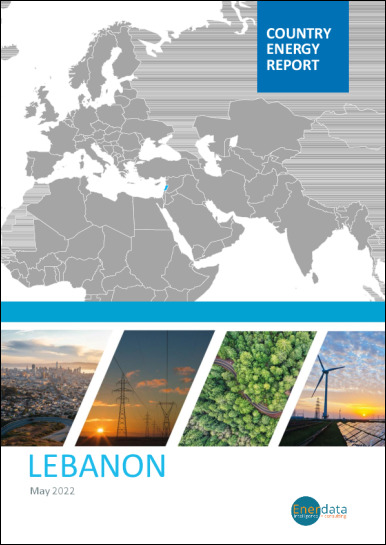- Update
-
- Format
- 3 files (PDF report, 2 Excel files)
- Pages
-
28 (Report only)
- Delivery
- Immediate by e-mail
- GENERAL OVERVIEW
- INSTITUTIONS AND ENERGY POLICY
- ENERGY COMPANIES
- ENERGY SUPPLY
- ENERGY PRICES
- ENERGY CONSUMPTION
- ISSUES AND PROSPECTS
- DATA TABLES
- ABBREVIATIONS
- GLOSSARY
Buy Lebanon energy report
Price without VAT. Depending on your statute and location, VAT might be applicable. Get in touch with us for more information.
After validation, you will immediately receive 3 files by email (one pdf report and 2 excel files containing the datasets).
Overview
This analysis includes a comprehensive Lebanon energy market report and updated datasets. It is derived from the most recent key economic indicators, supply and demand factors, oil and gas pricing trends and major energy issues and developments surrounding the energy industry. The report provides a complete picture of the country situation, dynamics, current issues and future prospects. With market data and continuous follow-up of markets news, this report brings clear and concise insights with which to tackle national energy challenges and opportunities. Browse the tabs below for a detailed table of contents, the list of graphs and tables, and details on the data files.
Highlights
- Renewables are expected to account for 18% of the power mix in 2030.
- State-owned EDL, which controls electricity generation and transmission, is a huge financial burden for the State because of its enormous debt.
- Public power generation has dropped by 46% since 2019. The country's electricity mix is based on oil (67%). The power deficit is high and increasing (over 40%).
- Lebanon is heavily dependent on imports of oil products.
- For the first time since 1994, EDL is raising electricity prices for industry and households.
- Total energy consumption decreased by 25% and electricity consumption by 36% in 2021.
- Most of the power projects are delayed because of the economic and political situation.
- Lebanon signed a deal to import 0.65 bcm/year of natural gas from Egypt via Syria through the Arab gas pipeline.
Institutions & Energy Policy
The Ministry of Energy and Water (MEW) supervises the electricity and oil sectors.
The Council of Development and Reconstruction (CDR) is a planning agency that coordinates the development of major projects. It was initially created to coordinate the reconstruction of the country after the civil war (1975-1990).
Energy Companies
Electricity:
Electricity of Lebanon (EDL) is the national electricity company.
Energy Supply
Resources:
Large offshore hydrocarbon fields are estimated to have oil and gas reserves resources of about 1 100 mbl and 600 bcm, respectively. However, the country currently has no commercial oil and gas reserves and drilling activities have been disappointing so far.
Energy Prices
Electricity:
The price of electricity is approved by the Ministry of Energy and Water, according to EDL's recommendations. On November 2022, the Lebanese authorities revised electricity tariffs, which had been unchanged since 1994 (previously US$10.9c/kWh for industry and US$5.3c/kWh for households), with the aim of restoring EDL's financial equilibrium and responding favourably to IMF requests.
Energy Consumption
Per capita energy consumption was 0.8 toe/cap in 2021 and per capita electricity consumption 1 540 kWh. In 2021, the per capita consumption of electricity fell by 36%.
Total energy consumption dropped by 25% in 2021 to 5.6 Mtoe. Since 2017, this consumption has decreased by 40%. It previously increased rapidly between 2011 and 2017 (around 6%/year).
Issues & Prospects
Electricity:
Lebanon has nearly 5.1 GW of projects under development (including 3.4 GW of thermal and 1.7 GW of renewables, mainly solar).
- GRAPH 1: CO2-Energy emissions (MtCO2)
- GRAPH 2: Installed electric capacity by source (2021, %)
- GRAPH 3: Gross power production by source (TWh)
- GRAPH 4: Power generation by source (2021, %)
- GRAPH 5: Gasoline & diesel prices (US$/l)
- GRAPH 6: Electricity prices for industry and households (US$c/kWh)
- GRAPH 7: Consumption trends by energy source (Mtoe)
- GRAPH 8: Total Consumption market share by energy (2021, %)
- GRAPH 9: Final consumption market share by sector (2021, %)
- Economic Indicators: Annual historical data including population, GDP growth, imports and exports, inflation rate, energy security and efficiency indicators, CO2 emissions.
- Supply Indicators: Historical data including oil and gas reserves, electric and refining capacity, energy production, power production and external trade. All are detailed by energy source.
- Demand Indicators: Historical data including consumption per inhabitant, consumption trends, total consumption by energy source, final consumption by energy source and sector, and electricity consumption by sector.
- Energy Balances: Single table displaying the overall energy industry balance per annum, also graphically displayed by energy sub-segment.
- Infrastructure Projects: Covers power plant projects by energy, technology, status and operator.
The Lebanon energy market data since 1990 and up to
is included in the Excel file accompanying the Lebanon country report.
It showcases the historical evolution, allowing users to easily work with the data.
Key Data included in the excelsheet:
- Economic indicators: Annual historical economic indicators, energy security, energy efficiency and CO2 emissions.
- Supply indicators: Annual historical reserves, capacity, production and external trade (imports(+) exports(-) balance).
- Demand indicators: Annual historical consumption per capita, consumption trends, total consumption, final consumption (per energy and per sector) and electricity consumption total and per sector.
- Energy Balance: total and per energy.
- Lebanon Energy Prices: In addition to the analysis provided on the report we also provided a data set which includes historical details on the Lebanon energy prices for the follow items: price of premium gasoline (taxes incl.), price of diesel (taxes incl.), price of electricity in industry (taxes incl.), price of electricity for households (taxes incl.), price of natural gas in industry (taxes incl.), prices of natural gas for households (taxes incl.), spot price of Brent and CO2 emissions (from fuel combustion).
 Energy and Climate Databases
Energy and Climate Databases Market Analysis
Market Analysis